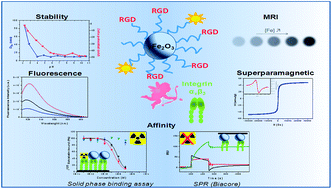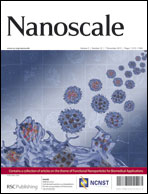Optimized multimodal nanoplatforms for targeting αvβ3 integrins†
Abstract
Magnetic Resonance Imaging (MRI) using contrast agents is a very powerful technique for diagnosis in clinical medicine and biomedical research. The synthesis of ultrasmall superparamagnetic iron oxide (USPIO) nanoparticles targeting αvβ3 integrins and acting as new MRI contrast agents seems to be a promising way for cancer diagnosis. Indeed, it is well established that αvβ3 integrin plays a key role in tumor angiogenesis acting like a receptor for the extracellular matrix proteins like vitronectin, fibronectin through the arginine-glycine-aspartic acid (RGD) sequence. Up-regulation of αvβ3 has been found to be associated with a wide range of cancers, making it a broad-spectrum tumor-marker. In this study, USPIO nanocrystals were synthesized and surface passivated with caffeic acid. The large number of the carboxylic acid functions at the outer surface of the nanoplatforms was used for the covalent coupling of Rhodamine123, polyethylene glycol (PEG) and cyclic RGD. Soluble carbodiimide (EDC) and N-hydroxysuccinimide (NHS) were used to crosslink carboxylic acid with the amino group of the ligands. We examined the design of the nanoplatforms with each individual entity and then the combination of two and three of them. Several methods were used to characterize the nanoparticle surface functionalization and the magnetic properties of these contrast agents were studied using a 1.5 T clinical MRI scanner. The affinity towards integrins was evidenced by surface plasmon resonance and solid-phase receptor-binding assay.

- This article is part of the themed collection: Functional Nanoparticles for Biomedical Applications

 Please wait while we load your content...
Please wait while we load your content...